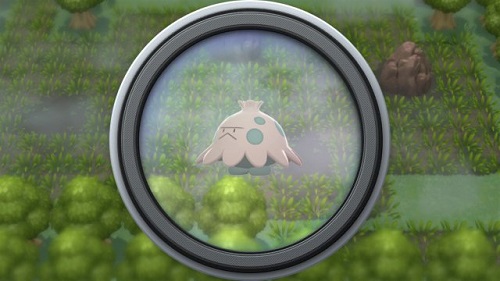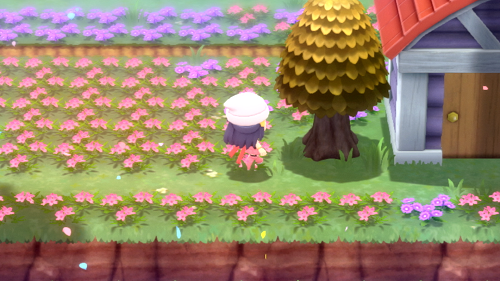I’ve been playing a lot of Pokémon Shining Pearl lately, in an effort to complete the game’s Pokédex. Because going through all that trouble once for the original game just wasn’t enough for me, I suppose. Gotta do it all again!
And as I sat on my couch a few nights ago, grinding away countless hours to complete my checklist of digital creatures, it dawned on me that Sinnoh is not the worst region in the Pokémon series because of its HMs, or its confusing and inconvenient map. No, Sinnoh is a pain in the butt because it has, by volume, the highest number of stupid gimmicks for finding pokémon.
The most obvious offender is the Great Marsh. Much like the Safari Zone from Pokémon Red/Blue/Yellow, the Great Marsh is a pay-to-play attraction that lets you go on a pokémon catching spree for either 500 steps or 30 safari balls. It’s not a bad feature, except for the fact that several rare creatures can only be found here, and they’re trapped behind not one, but four layers of RNG.

Firstly, there is a pool of fourteen pokémon, from which 1 to 6 creatures are randomly selected and dropped into the Great Marsh each day. Six of them cannot be found anywhere else. Next, you need to look through viewing binoculars to see which pokémon are present in the Marsh that day. The Great Marsh is divided into six areas, and it only shows you one of the pokémon available that day for five of the areas. So you could look through the binoculars a dozen times and only be shown the pokémon that inhabit the Marsh every day. But it’s still a lot more efficient than going right into the Great Marsh and just hoping to run across something rare in the grass. Which is the third level of RNG. Even once you see a rare pokémon in the binoculars, you still have to go in and rustle around in the grass, hoping that the next random encounter will be the lucky one. And then we get to the worst part…
The Great Marsh differs from the regular pokémon-catching mechanic by taking away your team of pokémon. So you no longer have to battle and weaken your target before trying to catch it; you just chuck balls at it and hope that it doesn’t run away. Which it probably will, because the flee rate is over 50% for all but two of the species you can find in the Great Marsh. You’re given the option to throw bait at a pokémon, which decreases the likelihood that it will run, but also decreases the likelihood that it will be caught. Or you can throw a rock at it, which does the opposite. So what I’m getting at here is, the Great Marsh is terrible because it takes away all relevant player input from the pokémon catching process and forces you to succumb to the whims of the random number generator.
But even that’s not so bad, because as dumb as it is, you can play the Great Marsh as much as you want. Or at least, as long as you have money (and it only costs 500 pokédollars, not exactly breaking the bank). So if you’ve seen a rare pokémon in the binoculars, you can just grind it out until the planets align and you make that catch. Honey trees are not so kind.
Honey trees are special, yellowish-coloured trees dotting the landscape. When you find one, you can slather honey on it, and then come back six hours later and a pokémon will show up! There are only eight species of pokémon that can be found via honey tree (and only two are exclusive to the feature), and while the rarest are only a 5% spawn, honey is cheap and the trees are plentiful, so how bad could it be?

Well, my friends, it gets really bad. One pokémon, Heracross, is one of those 5%ers, and can only show up on four specific honey trees. Again, doesn’t seem so bad – until you learn that those four trees are randomized for every save file. So you get to run around the world map slathering honey on as many trees as you can bear, and then do it all again six hours later to see what showed up. If anything showed up, because there’s a 10% chance that a pokémon simply will not spawn. The only way to tell which trees are your special trees is if a Silcoon/Cascoon pops out, since they cannot spawn from the same trees as Heracross. And while you can slowly cross off trees on your map as you go, it’s still a painful grind that requires you to wait at least six hours per attempt. This kind of garbage is exactly why I don’t play mobile games. And also because if this was a mobile game, the honey would cost real-world currency.
The last dumb gimmick has been revamped from the original games, but in the stupidest possible way. Generation 4 introduced a new ghost-type pokémon called Spiritomb. You make this pokémon appear by placing an item into a particular object in the environment, and then going to the Underground and talking to 32 people. In the original games, the Underground was a multiplayer feature, and so it required you to talk to other players 32 times. While it was a bit of a hassle since online gaming was still in its infancy at that time, you could easily link up with another player in-person and then just talk to each other 32 times. Tedious, but otherwise easy-peasy. Once that’s done, you go back to the surface and check the thing you put the other thing into, and bam! Spiritomb.
Now you would think that in the age where online gaming is fairly well-established, this goal would be easier than ever. But no! Someone at ILCA saw fit to go the opposite way, and in the remakes, you now need to talk to 32 NPCs in the Grand Underground. 32 individual NPCs, out of a pool of 35. Who spawn randomly. And while it’s not a difficult task by any means, the fact that it’s been turned “offline” makes it take so much longer to accomplish than it should. It’s easily the most baffling change in the entire game, and I cannot fathom what led the developer to do such a thing. Why not count both other players and NPCs? That way it’s less of a tedious grind, but can still be accomplished by players who are completely offline and have no friends. I just don’t get it.
But those are all of my gripes! It was nice to play through a slightly more robust version of Pokémon Pearl, and while it does sport a number of improvements over the original, it’s sad to see that all of the worst parts were left as-is. Or, somehow, made worse.
